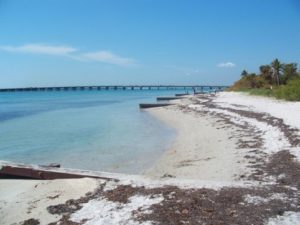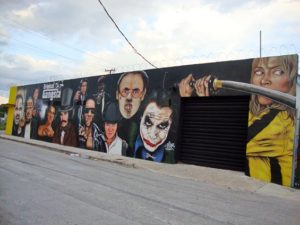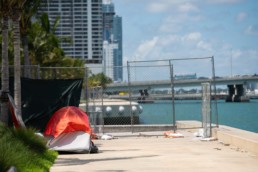Searching for Answers in Miami: Where Beauty Blurs Reality...
I jumped at the opportunity to reflect on my first site visit as a member of the 2017 PLACES Fellowship cohort. I felt compelled to share and work through a few observations that confounded and still perplex me. I hoped to stimulate a conversation with an audience larger than the ones I typically have the privilege of addressing.
But if I am honest, I found this exercise far more difficult than I had initially anticipated. It’s not because I have trouble expressing myself in writing—as a grant writer you eventually make peace with this unique method of torture—but because the moments of dissonance I experienced in Miami led to questions for which I had no answers. Instead, they have led to many more questions.
 During our first group module, I was pleased to discover that my initial expectations for the PLACES Fellowship did not match what I was beginning to learn about my class and about the program. I had grown weary of the diversity/inclusion/cultural sensitivity “conversations”, which have become an increasingly common response to our fraught political climate. I wrongly assumed that this fellowship would be more of the same. And yet, the very location of our opening activity, the historic Virginia Key Beach, dispelled this belief. It immediately spoke to the tension between narrative/belief/appearance and lived reality, a recurring theme throughout the site visit. The beauty of this particular setting obscured its complicated history of racial conflict, exclusion and segregation, as well as allegations of environmental racism. From my own experience in Miami, I saw similar examples of the peculiar way in which beauty often blurs reality.
During our first group module, I was pleased to discover that my initial expectations for the PLACES Fellowship did not match what I was beginning to learn about my class and about the program. I had grown weary of the diversity/inclusion/cultural sensitivity “conversations”, which have become an increasingly common response to our fraught political climate. I wrongly assumed that this fellowship would be more of the same. And yet, the very location of our opening activity, the historic Virginia Key Beach, dispelled this belief. It immediately spoke to the tension between narrative/belief/appearance and lived reality, a recurring theme throughout the site visit. The beauty of this particular setting obscured its complicated history of racial conflict, exclusion and segregation, as well as allegations of environmental racism. From my own experience in Miami, I saw similar examples of the peculiar way in which beauty often blurs reality.
During the site visit, we heard from a multitude of Miami representatives: local foundations and funders, elected officials, academic institutions, and nonprofit community groups. These groups shared their own perspectives on Miami. Most agreed that Miami is a young but rapidly developing international city. They are proud of its uniquely diverse and multilingual cultures. Though I was aware of and intrigued by the prominence of the Latin American (particularly Cuban-American) influence on the evolution of Miami as a city, I suspected that the standard narrative of a multicultural utopia was not the only narrative.
At the Little Haiti Cultural Complex, we participated in a panel discussion featuring two incredible journalists: Nadege Green and Ana Menendez. We learned of the differences in the lived experiences of Haitian immigrants in Miami compared to those of most Cuban immigrants. The panelists described how in Miami, Cuban identity is affirmed (if not privileged) in ways that other cultural identities are not: through inequitable immigration policies, the realities of local politics, and the many other complex issues related to race, socioeconomic status and language. This further complicated my understanding of race and identity in Miami, while providing insight into dynamics I had not previously acknowledged.
As in my own hometown of Cleveland, Ohio (and in most American cities), there are essentially two Miamis. There is the Miami of popular imagination: a tourist’s paradise for some, and a retirement destination for others; a place where luxury items seem to grow on trees. The other Miami is just out of sight but never really gone. The story of this Miami is often told in numbers (such as crime statistics, health disparities, etc.) or synthesized into digestible euphemisms, including “historically disadvantaged”. This Miami, if seen at all, is nearly always examined—however sympathetically—from the safe distance of the ivory tower, a documentary filmmaker’s lens, or in our case a bus full of philanthropy professionals. But safety is an illusion, and distance only further obscures reality.
 I watched Miami’s multiple identities pass us by from the comfort of my bus seat: historic Little Havana, the “emerging” arts district of Wynwood, and the ever vibrant and resilient Little Haiti. While driving by, I keenly observed the stark contrast between encouraging signs of progress/prosperity on some streets only to be quickly met with the sobering images of decline/despair a few blocks away. I was struck that this contrast was eerily mirrored in the scale and sophistication of the public art installations in public spaces. This contrast announces the transition out of “the hood” and into an up-and-coming neighborhood (or vice versa). After a mile or so of remarkably sophisticated murals, I was struck by a spray-painted quote on the side of a corner store just above a memorial to pop culture’s pantheon of (in)famous gangsters like Tony Montana. It read: God is on a $moke Break. These words gave me pause. In their bitter cynicism, I heard an indictment of the unequal system, which produced, and then ignored, this hopeless place.
I watched Miami’s multiple identities pass us by from the comfort of my bus seat: historic Little Havana, the “emerging” arts district of Wynwood, and the ever vibrant and resilient Little Haiti. While driving by, I keenly observed the stark contrast between encouraging signs of progress/prosperity on some streets only to be quickly met with the sobering images of decline/despair a few blocks away. I was struck that this contrast was eerily mirrored in the scale and sophistication of the public art installations in public spaces. This contrast announces the transition out of “the hood” and into an up-and-coming neighborhood (or vice versa). After a mile or so of remarkably sophisticated murals, I was struck by a spray-painted quote on the side of a corner store just above a memorial to pop culture’s pantheon of (in)famous gangsters like Tony Montana. It read: God is on a $moke Break. These words gave me pause. In their bitter cynicism, I heard an indictment of the unequal system, which produced, and then ignored, this hopeless place.
Later in the afternoon we stopped at Little Haiti’s local chapter of Gang Alternatives, Inc. Almost immediately we were notified that the organization’s executive director had been called away to provide support to the family of one of the program participants who had suffered a gunshot wound earlier that day. We would soon learn that while we were at the Gang Alternative facility, the young man who had been shot had passed away from his injuries.
This was, for me, the most difficult collision to reconcile. Though I had never met the young man, I felt a responsibility to him, which I could not explain. I was overwhelmed by an unshakable sense of guilt and helplessness. I was angry, frustrated, and utterly demoralized. As the group tried valiantly to complete the afternoon’s scheduled activities, I was admittedly distracted. Yet, I found comfort in the realization that my fellow Fellows were also struggling to come to terms with what we had been seeing, hearing, and feeling. In that moment I felt a certain kinship, which I did not expect to develop so soon (if at all) with my cohort. It was not until I returned to Cleveland and attempted to write, that I began to see the value in “self-care” and community.
Before this site visit, I dismissed the very idea of self-care as a luxury I could not afford, nor one I deserved to indulge in. With the support of my new colleagues and the guidance of the PLACES team (Dion Cartwright, Bina Patel and Scot Spencer), I began to understand self-care differently. I began to see self-care as a form of resistance—a proactive approach to resiliency in this work. I began to understand this practice as a protective measure to help me withstand and persevere in the face of the overwhelming weight of the social problems that each us, by virtue of our presence in the field of philanthropy, had committed to solving. Reflecting on my week-long series of collisions, it became clear to me just how desperately I needed to embrace this praxis—not only for my own sanity, but in order to summon the strength necessary to do this urgent work against seemingly insurmountable odds.
Check out our first Going PLACES blog post here.
 Mordecai Cargill
Mordecai Cargill
Manager of Fund Development
Cleveland Neighborhood Progress
CNP is a community development funding intermediary committed to fostering inclusive neighborhoods of choice and opportunity throughout the city of Cleveland. Mordecai provides oversight and management of all grantseeking processes for CNP and its subsidiaries. Mordecai’s role has evolved significantly since joining Team CNP in 2014, and now includes project management for strategic initiatives such as an Organizational Assessment (2014), and the planning process for the 2017-2021 Cleveland Neighborhood Progress Strategic Plan (2016). He also contributes to CNP’s emerging Policy, Advocacy & Research body of work. Additionally, he leads the organization’s efforts to elevate racial equity and inclusion as a citywide community development priority. Mordecai earned his Bachelor of Arts in African American Studies from Yale University, with a concentration on black culture in the 20th Century. He was awarded the William Pickens Prize for his senior thesis, “The Black Arts Iconography of John Coltrane.”

